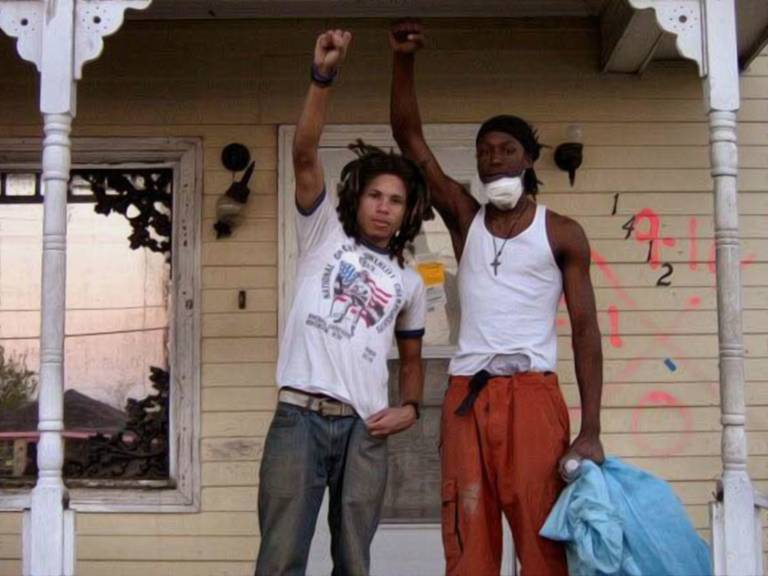A resource guide on Katrina and the ongoing efforts by residents to rebuild the city of New Orleans
“Imagine that you truly believed in your heart that your government wanted to kill you,” Curtis Muhammad said, standing in front of the Industrial Canal levee in New Orleans’ Lower Ninth Ward. He went on to describe three instances of dynamiting levee systems in poor neighborhoods of New Orleans to relieve pressure on commercial districts of the city: the Great Mississippi River Flood of 1927, during Hurricane Betsy in 1965, and once more in August of 2005 during Hurricane Katrina. Older residents of the neighborhood recalled hearing the levee break twice in their lifetimes, and swore it was explosives.
Almost 10 years ago, I traveled to New Orleans as a 14-year-old high school student. I got involved, as a white volunteer, with a Black-led organization, the People’s Organizing Committee, that was organizing meetings of residents of the Lower Ninth to strategize how to rebuild and move their neighbors back who had been displaced all across the country post-Katrina. They didn’t speak of reforms and there was no appealing to the state to stop killing them. They wanted to organize their own plan to return. Group leaders I was working with insisted white people speak last in evening debriefs and during door knocking getting people out to meetings. This wasn't the “progressive stack” I would later learn about during Occupy; it was the prioritization of poor Black militants who spoke of building their own levee, opening freedom schools, and divesting from the state.
This past week, I’ve been thinking about the strength and resiliency of the residents of New Orleans who were able to move back home, and the amount of people who came through the city in solidarity, and many more who came in charity.
I’ve been thinking about how anti-Black violence is still a wingnut idea to many people. “The government tried to kill 100,000 Black people in New Orleans.” That photo of Bush sitting comfortably in Air Force One as people stood on their rooftops in the southern heat for days, while others drowned in their attics. 10 years later, there are no public schools open in the Lower Ninth. There is a single grocery store.
Whenever I have doubts about the state blowing up a levee, I return to Curtis’ words.
---
Below is a collection of readings, videos, and resources on Hurricane Katrina and various rebuilding efforts throughout the city. While we reflect on the spectacle of Black death, and how very little has changed, remember that people are still fighting.
Overview of Hurricane Katrina and Aftermath
[Video] Trouble the Water documentary by Tia Lessin and Carl Deal
1 Dead in Attic by Chris Rose
Come Hell or High Water: Hurricane Katrina and the Color of Disaster by Michael Eric Dyson
[Video] When the Levees Broke: A Requiem in Four Parts documentary by Spike Lee
Teaching the Levees curriculum
The People of New Orleans on Hurricane Katrina and Its Aftermath by Chris Ying and Lola Vollen
How to Destroy an African-American City in Thirty-Three Steps: Lessons From Katrina by Bill Quigley
Play-by-play and flood map of Hurricane Katrina in The New York Times
Katrina and the politics of disposability by Henry Giroux
Investigation into the Danziger Bridge shootings
From Katrina to Sandy, FEMA rumors and failures keep swirling by Michael Moynihan
Mayor during Katrina found guilty of corruption, sentenced to 10 years
Material Conditions of New Orleans
Search New Orleans zip codes on USDA’s food desert locator. The Lower Ninth Ward’s zip code is 70117. (While you are at it, look up data for your own city as well.)
Income inequality, renter and homeowner breakdowns, population density data
Katrina Truth: research facts on the local realities of queer/trans people of color, environmental injustice, police violence and incarceration, economic disparities, and more.
[Infographic] Race and displacement 10 years after Katrina by Colorlines
A history of New Orleans public housing via No Limit and Ca$h Money music videos by Brentin Mock
Rising Tide: The Great Mississippi River Flood of 1927 and How It Changed America by John M. Barry
Queerness matters post-Katrina by Charlotte D’Ooge
The Effects of Hurricane Katrina on Food Access Disparities in New Orleans by students and faculty at Tulane University
Police existence is police brutality
Schools
Charter Schools, Race, and Urban Space: Where the Market Meets Grassroots Resistance by Kristen Buras
Shock Doctrine: A Look at the Mass Privatization of NOLA Schools in Storm’s Wake by Democracy Now!
The first school to reopen after Katrina, Martin Luther King Jr. Charter School, was an unsanctioned cleanup effort by Common Ground Collective
[Podcast] The Promised Land on voices from the Gulf Coast: Nat Turner interviewed by Majora Carter
[Video] Reversing the Mississippi by Ian Midgely
Movements, Insurrection, Rebuilding, and Repression
$700 Million in Katrina Relief Funds Missing by Jeff Zeleny
Floodlines: Community and Resistance from Katrina to the Jena Six by Jordan Flaherty
Driven from New Orleans: How Nonprofits Betray Public Housing and Promote Privatization by John Arena
Black Flags and Windmills by scott crow
Why Misogynists Make Great Informants: How Gendered Violence on the Left Enables State Violence in Radical Movements by INCITE! Women of Color Against Violence
[Video] LGBTQ youth group BreakOUT! featured on their post-Katrina organizing
Special thanks to Servius, Pablo, Alex, Queen, Raven, Jenny, and all the pedagogues who suggested readings, videos, ideas for this list.
